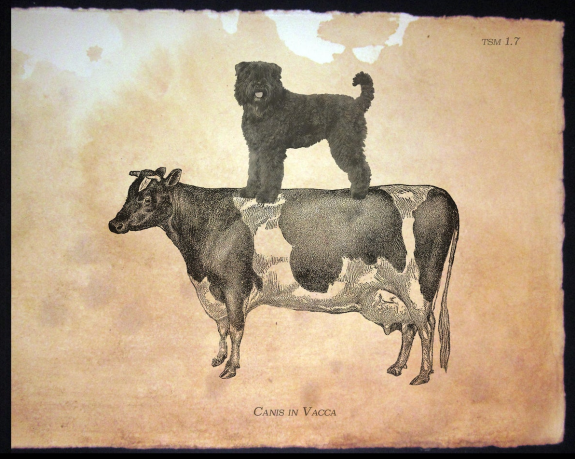
Dr. Aldolphe Reul of the Curegheun Veterinary School of Brussels was the first person to bring attention to the Bouvier des Flandres’ fine qualities. In the early 1900s, he wrote of the speed and courage of these dogs, and described how they would jump high in the air on all four legs to avoid the hooves of cattle. He added that cows who had showed aggression towards other dogs would be wary of the Bouvier des Flandres, and too intimidated to confront one. Professor Reul advised that it would be well worth encouraging the development of this type of dog.
At that point, the breed found mostly in South West Flanders and on the French Northern plain was owned by people who occupied themselves with cattle: Ranchers, cattle merchants, farmers, and butchers. With its heavy cylindrical body and aptitude for moving cattle, the dog was an indispensable helpmate that could also pull small carts for bakers or milkmen, and have the strength to turn a milk churn.
It probably perplexed working folk, then, when four so-called “Bouviers” appeared at a dog show in Hasselt in July 1900. The following year, three “Bouviers” were shown in Brussels, but they looked more like Briards which hinted at dalliances between the sheepdogs of Northern France and the Belgian dogs. At a show in 1903, Professor Reul saw a dog named “Tom,” who may have given Professor Reul the inspiration to draw up a provisional Breed Standard.
The Societe Royale St. Hubert took notice of the breed when it appeared at show benches at the International Dog show of May 1910 in Brussels. The two Bouviers shown there were “Nelly” and “Rex” (and as an aside, it should be noted that in the 1900’s, the breed known as the “Flemish Droving Dog” became much more popular in Wallonia where it became better known by its French name, Bouvier des Flandres, or “Cow-Herder Dog of Flanders.” Because it was the French speaking Wallonians who popularized the breed outside of Belgium, the French name stuck). Rex and Nelly belonged to a Monsieur Paret, a Bouvier fancier of Ghent, and it is this gentleman who is considered to have established the foundation bloodlines of the Bouviers as we see them today.
That said, a breed standard wasn’t adopted until 1912 when Mr. Fontaine, vice-president of the Club St Hubert du Nord, drew it up with the input of a society of Bouvier breeders and experts founded in Roulers (West-Flandres).These individuals promulgated the standard of perfection and that became the first official standard to be recognized by the Societe Royale St. Hubert.
Image: “Bouvier des Flandres (with tail) Riding Cow” by Elliott, Owner of TeaStainedMadness is available for purchase here

I’ve never met an unfriendly bouvier and we know quite a few. Because of that, we now have two bouviers; they are loving, fun dogs. Our little girl, Whiskey, is brilliant and a bit stubborn and our big baby boy, Jinjin, isn’t bright but is pure sugar; that just makes it all the more fun.
Isn’t wonderful how they can all be the same breed, and share characteristics of that breed, but be such individuals? Your crew sounds like a lot of fun!